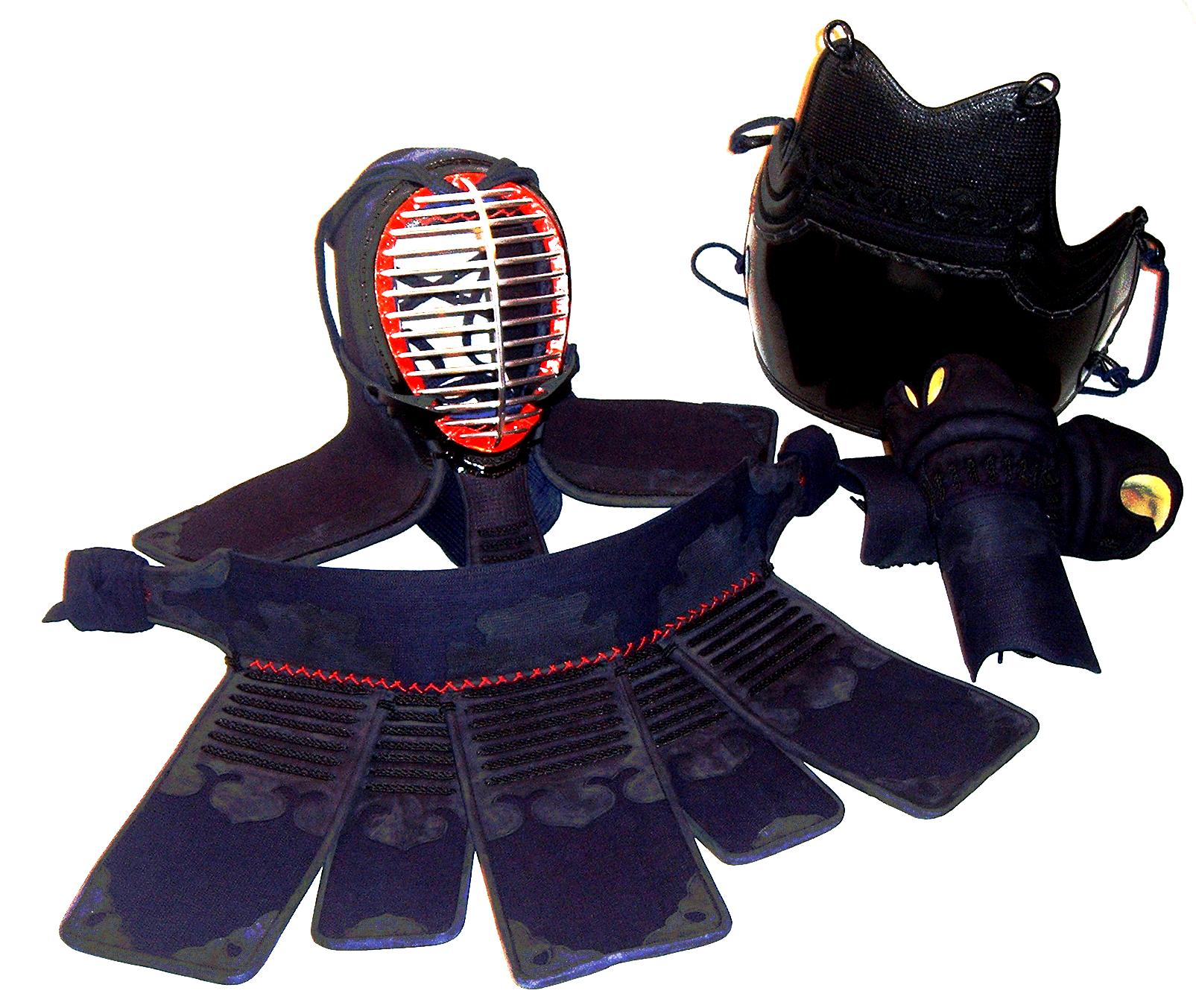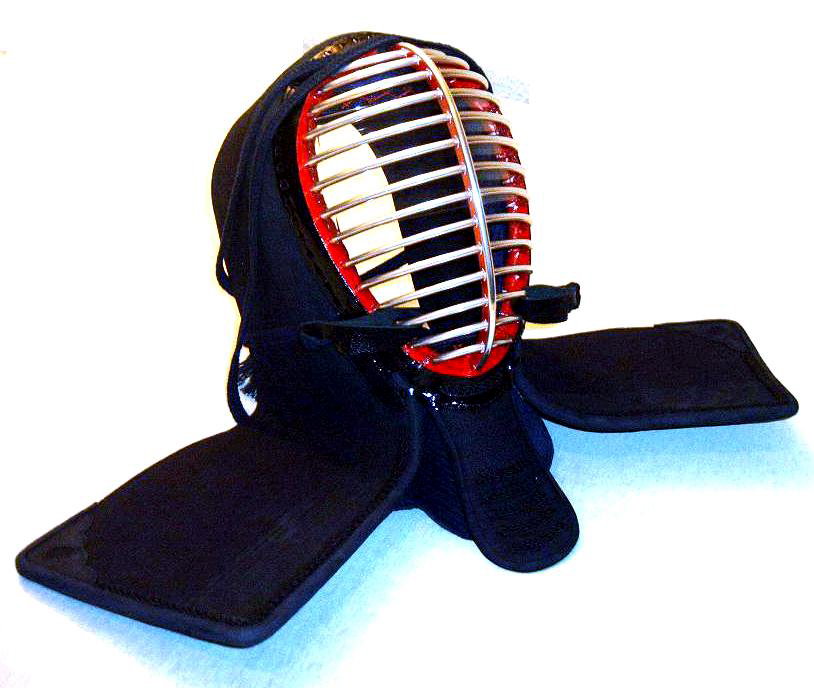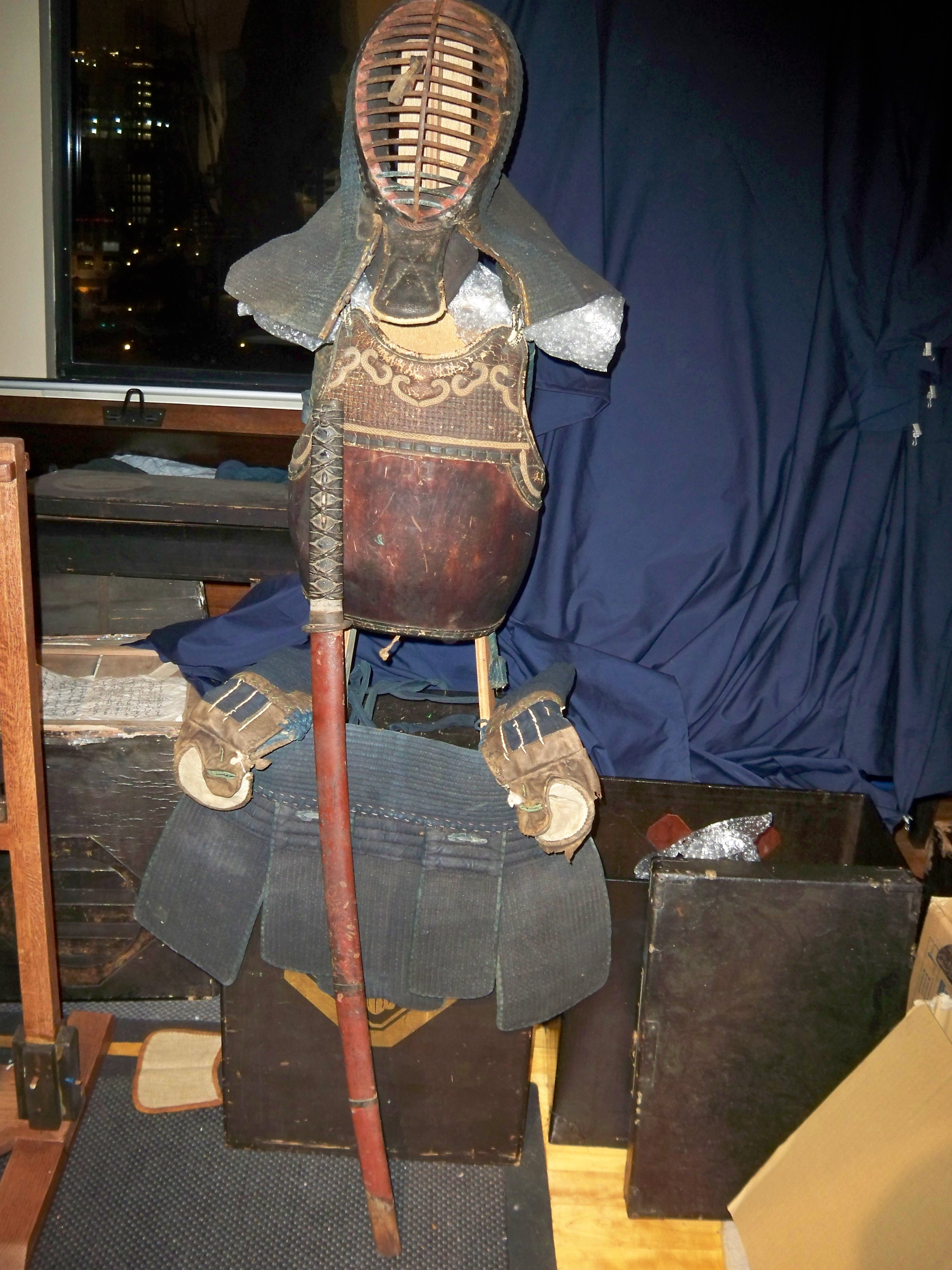Bōgu on:
[Wikipedia]
[Google]
[Amazon]

 , properly called , is training armour used primarily in the
, properly called , is training armour used primarily in the
Kendo Bogu (Protective Equipment)
(October 2005). Retrieved on 12 May 2010.
(2002). Retrieved on 12 May 2010. with variants used for jūkendō, tankendo, and
 The protects the face, neck, and shoulders. It consists of a facemask with several horizontal metal bars running the entire width of the face, from the chin to the top of the head. To this is attached a long rectangular thick cloth padding that curves over the top of the head and extends to cover the shoulders. A throat protector is attached to the bottom of the facemask. The is held in place with a pair of woven cords that wrap around the head and are tied at the back. The back of the is left open for ventilation and the back of the head is unprotected. The target areas of the are the centre top, and upper left and right sides for cutting strikes and the centre of the throat protector for a thrust.
The protects the face, neck, and shoulders. It consists of a facemask with several horizontal metal bars running the entire width of the face, from the chin to the top of the head. To this is attached a long rectangular thick cloth padding that curves over the top of the head and extends to cover the shoulders. A throat protector is attached to the bottom of the facemask. The is held in place with a pair of woven cords that wrap around the head and are tied at the back. The back of the is left open for ventilation and the back of the head is unprotected. The target areas of the are the centre top, and upper left and right sides for cutting strikes and the centre of the throat protector for a thrust.
 The are mitten-like gloves. They were designed expressly for kendo. While appearing to be cumbersome, enough mobility is allowed to grip the in a comfortable, powerful, and firm way. for naginatajutsu practitioners have a singulated index finger and thumb to better facilitate the rapid shifting of the hands along the length of the 's shaft. have a little less padding than those used for kendo. In the past, were often made with fully articulated fingers. This is rarely seen today as there can be a safety issue with snagged fingers. A special heavily padded design known as are used by some , most notably Itto-ryu. The target area is the wrist portion of each .
The are mitten-like gloves. They were designed expressly for kendo. While appearing to be cumbersome, enough mobility is allowed to grip the in a comfortable, powerful, and firm way. for naginatajutsu practitioners have a singulated index finger and thumb to better facilitate the rapid shifting of the hands along the length of the 's shaft. have a little less padding than those used for kendo. In the past, were often made with fully articulated fingers. This is rarely seen today as there can be a safety issue with snagged fingers. A special heavily padded design known as are used by some , most notably Itto-ryu. The target area is the wrist portion of each .
 The main component of the is the gently-curving stomach and chest protector. The modern form has a pronounced bulge to help direct the force of strikes away from the soft areas in the middle of the torso. Lacquered bamboo is traditionally used although lacquered paper 'fibre' (frequently misidentified as
The main component of the is the gently-curving stomach and chest protector. The modern form has a pronounced bulge to help direct the force of strikes away from the soft areas in the middle of the torso. Lacquered bamboo is traditionally used although lacquered paper 'fibre' (frequently misidentified as
 The is a thick cloth belt that wraps around the waist and ties under the front flap in front of the groin. Sturdy cloth covered flaps hang from the belt to protect the upper legs and groin. The flaps run along half of the belt's length, which should be positioned over the front half of the body. The centre flap is usually covered with a name tag— or —that identifies the name of the wearer and the or country they represent. There is no target point on , it is for protection against off-target and accidental strikes.
The is a thick cloth belt that wraps around the waist and ties under the front flap in front of the groin. Sturdy cloth covered flaps hang from the belt to protect the upper legs and groin. The flaps run along half of the belt's length, which should be positioned over the front half of the body. The centre flap is usually covered with a name tag— or —that identifies the name of the wearer and the or country they represent. There is no target point on , it is for protection against off-target and accidental strikes.
 *
*

Japanese martial art
Japanese martial arts refers to the variety of martial arts native to the country of Japan. At least three Japanese terms (''budō'', ''bujutsu'', and ''bugei'') are used interchangeably with the English phrase Japanese martial arts.
The usage ...
of kendo
is a modern Japanese martial art, descended from kenjutsu (one of the old Japanese martial arts, swordsmanship), that uses bamboo swords (shinai) as well as protective armor (bōgu). Today, it is widely practiced within Japan and has spread ...
,Uchida, M. (2005)Kendo Bogu (Protective Equipment)
(October 2005). Retrieved on 12 May 2010.
(2002). Retrieved on 12 May 2010. with variants used for jūkendō, tankendo, and
naginata
The ''naginata'' (, ) is a pole weapon and one of several varieties of traditionally made Japanese blades (''nihontō''). ''Naginata'' were originally used by the samurai class of feudal Japan, as well as by ashigaru (foot soldiers) and sōhei ...
.
History
During theEdo period
The or is the period between 1603 and 1867 in the history of Japan, when Japan was under the rule of the Tokugawa shogunate and the country's 300 regional '' daimyo''. Emerging from the chaos of the Sengoku period, the Edo period was characteriz ...
(1603-1868) the use of real swords for training purposes was discouraged due to injuries, with wooden practice swords in the form of and were often used instead. To further reduce injuries, practice armour based on traditional samurai armor was developed, with this practice armour being the basis for the modern .
Description and use
The word consists of two parts: , meaning "protect" or "defend," and , meaning "equipment" or "tool." A set of has four components: * : combined face mask and shoulder protectors (helmet
A helmet is a form of protective gear worn to protect the head. More specifically, a helmet complements the skull in protecting the human brain. Ceremonial or symbolic helmets (e.g., a policeman's helmet in the United Kingdom) without protect ...
);
* : hand and forearm protectors ( gauntlets);
* : torso protector (breastplate
A breastplate or chestplate is a device worn over the torso to protect it from injury, as an item of religious significance, or as an item of status. A breastplate is sometimes worn by mythological beings as a distinctive item of clothing. It is ...
);
* : groin and leg protectors (faulds
Faulds can refer to:
* Andrew Faulds (1923-2000), British actor and politician
*Clare Faulds (born c. 1949), Manx lawyer and vicar
*Henry Faulds (1843-1930), Scottish scientist who is noted for the development of fingerprinting
* Kristopher Faulds ...
).
A fifth component, (shin protectors, or greave
A greave (from the Old French ''greve'' "shin, shin armour") or jambeau is a piece of armour that protects the leg.
Description
The primary purpose of greaves is to protect the tibia from attack. The tibia, or shinbone, is very close to the ski ...
s), are worn by naginatajutsu practitioners.
 The protects the face, neck, and shoulders. It consists of a facemask with several horizontal metal bars running the entire width of the face, from the chin to the top of the head. To this is attached a long rectangular thick cloth padding that curves over the top of the head and extends to cover the shoulders. A throat protector is attached to the bottom of the facemask. The is held in place with a pair of woven cords that wrap around the head and are tied at the back. The back of the is left open for ventilation and the back of the head is unprotected. The target areas of the are the centre top, and upper left and right sides for cutting strikes and the centre of the throat protector for a thrust.
The protects the face, neck, and shoulders. It consists of a facemask with several horizontal metal bars running the entire width of the face, from the chin to the top of the head. To this is attached a long rectangular thick cloth padding that curves over the top of the head and extends to cover the shoulders. A throat protector is attached to the bottom of the facemask. The is held in place with a pair of woven cords that wrap around the head and are tied at the back. The back of the is left open for ventilation and the back of the head is unprotected. The target areas of the are the centre top, and upper left and right sides for cutting strikes and the centre of the throat protector for a thrust.
 The are mitten-like gloves. They were designed expressly for kendo. While appearing to be cumbersome, enough mobility is allowed to grip the in a comfortable, powerful, and firm way. for naginatajutsu practitioners have a singulated index finger and thumb to better facilitate the rapid shifting of the hands along the length of the 's shaft. have a little less padding than those used for kendo. In the past, were often made with fully articulated fingers. This is rarely seen today as there can be a safety issue with snagged fingers. A special heavily padded design known as are used by some , most notably Itto-ryu. The target area is the wrist portion of each .
The are mitten-like gloves. They were designed expressly for kendo. While appearing to be cumbersome, enough mobility is allowed to grip the in a comfortable, powerful, and firm way. for naginatajutsu practitioners have a singulated index finger and thumb to better facilitate the rapid shifting of the hands along the length of the 's shaft. have a little less padding than those used for kendo. In the past, were often made with fully articulated fingers. This is rarely seen today as there can be a safety issue with snagged fingers. A special heavily padded design known as are used by some , most notably Itto-ryu. The target area is the wrist portion of each .
 The main component of the is the gently-curving stomach and chest protector. The modern form has a pronounced bulge to help direct the force of strikes away from the soft areas in the middle of the torso. Lacquered bamboo is traditionally used although lacquered paper 'fibre' (frequently misidentified as
The main component of the is the gently-curving stomach and chest protector. The modern form has a pronounced bulge to help direct the force of strikes away from the soft areas in the middle of the torso. Lacquered bamboo is traditionally used although lacquered paper 'fibre' (frequently misidentified as fiberglass
Fiberglass (American English) or fibreglass (Commonwealth English) is a common type of fiber-reinforced plastic using glass fiber. The fibers may be randomly arranged, flattened into a sheet called a chopped strand mat, or woven into glass cloth ...
) or moulded plastic are used for less expensive . The is supported from the shoulders by two diagonal ties and is restrained at the small of the back with another set of ties. The target areas of the are the two lower sides for a slashing cut to the stomach. The top half of the is a valid target for a thrust in naginata. In the past, this was also a valid target for a thrust in Kendo.
 The is a thick cloth belt that wraps around the waist and ties under the front flap in front of the groin. Sturdy cloth covered flaps hang from the belt to protect the upper legs and groin. The flaps run along half of the belt's length, which should be positioned over the front half of the body. The centre flap is usually covered with a name tag— or —that identifies the name of the wearer and the or country they represent. There is no target point on , it is for protection against off-target and accidental strikes.
The is a thick cloth belt that wraps around the waist and ties under the front flap in front of the groin. Sturdy cloth covered flaps hang from the belt to protect the upper legs and groin. The flaps run along half of the belt's length, which should be positioned over the front half of the body. The centre flap is usually covered with a name tag— or —that identifies the name of the wearer and the or country they represent. There is no target point on , it is for protection against off-target and accidental strikes.
See also
Hogu
Hogu (호구) is the armor worn by practitioners of Taekwondo and Geomdo during sparring and competition. Translated into English, ''hogu'' means chest or chest protector.
The ''hogu'' has been used in World Taekwondo sparring since the 1950s an ...
– armour worn by taekwondo athletes during sparring
References
{{DEFAULTSORT:Bogu Japanese martial arts terminology Kendo Japanese martial arts equipment Japanese armour Samurai armour